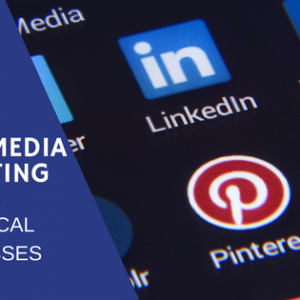
Marketing through social media may seem like high tech sorcery, full of analytics and algorithms painting a story of likes, shares, and re-posts. But it can be done successfully and there are lots of different ways and reasons to do it. This is one reason why it’s so complicated.
If you’re running a local business, you likely don’t have a lot of experience running a campaign. That’s fine! We all start somewhere. This brief guide will help you get your bearings.
Why Market With Social Media?
The usual goals of marketing are to prime people for sales and raise awareness about your business. While there are other methods of doing so like PPC and search engine marketing there are many things that only social media can assist you with. It can teach you a lot about your customers and how they interact online. It can funnel the people in your audience who are most likely to convert. It can serve as a customer service platform, or even as a method for boosting your website’s search rankings. But probably it’s most important feature is that it helps you build relationships with your customers.
While all of these reasons can be important to your business, it’s best to focus on a singular reason and a single social media platform to start. There is no rush to master everything about it, and trying to do too much at once is a sure road to online marketing burnout.
The foundation for success in social media marketing is developed through knowing the chosen platform, your audience, the competition you’ll face, content creation, and monitoring the campaign over time. Here are some tips for new people learning these things and how to leverage them so you can have a successful campaign.
Which Social Media Platforms?

Successful campaigns don’t include every platform. If you are new to social media marketing, choose one platform and master it first. We can’t stress this enough. Most brands will never need more than three platforms. Concentrate on the platforms where your audience hangs out. Forbes has a useful guide for deciding which platform might be best for your company at the time of this writing.
Your choice may also be influenced by the type of content you want to generate. Facebook ranks videos higher than any other type of post. Facebook also supports 360-degree photos and video and has a video carousel feature allowing five photos to be viewed in a single post. But if photos and videos aren’t in your wheelhouse, choose something like Twitter, which focuses more on text.
Also, don’t neglect LinkedIn. Many professionals (over 500 million) use LinkedIn. Brands working in industries that support freelance work, like graphic design, writing and photography are particularly suitable to LinkedIn. In fact, we’ll go so far as to suggest you at least build a LinkedIn profile for your business. Just having the profile will make you more professional. You can learn how to master it later.
Audience Personas
Since social media campaigns are meant to engage with people you need to know the type of people your customers are. Different groups respond better to different kinds of copy. This is marketing 101, but too many businesses just throw generic messages into social media pages like bait and hope someone picks it up. You can do better by targeting the type of people you want to attract through your knowledge of them.
One pitfall of social media campaigns is targeting people you can’t serve. If you have a local business, use indicators in your profiles like location settings to filter out people who aren’t local. Indeed, if PPC or Facebook Ads are going to be part of your campaign this is crucial to avoid wasting money!
Knowing the Competition

Reviewing the competitor’s progress regularly and examining companies with both successful and failing social media campaigns will provide guidelines for improvement. The similarities and differences offer a perspective on how you should shape your own campaign. Here’s an example for Instagram.
Instagram is a great place to hold contests. In 2013, Mercedes Benz held a contest on Instagram hiring five influencers to drive the new Mercedes CLA for five days. Whoever got the most likes got to keep the car, a $32,000 prize!
By the close of the campaign Mercedes received:
- 87 million organic Instagram engagements.
- 2 million likes.
- 150 marketing photos.
There are so many ways your competitors might be using social media that it’s difficult to generalize strategies. The best thing to do, especially if you’re new, is to observe them. Are they getting a good response or not?
Consistent, Quality Content
There’s no magic trick when it comes to content. It takes effort, research and lots of creativity. Here are some things that could inspire your content pieces:
- Content must be visually compelling.
- Keeps an eye on what’s trending on Twitter even if it’s not one of your platforms. Out of the major platforms, it provides the most real-time information. Say there’s a big music festival in Chicago. You can find out the hashtag for it and create content related to the festival, such as a Facebook Live video.
- Leverage current events to take advantage of making a connection. Look at the Oreo campaign from 2013 when the Super Bowl lost power. Oreo tweeted “You can still dunk in the dark,” and was retweeted 15 thousand times. Another good example of tying a brand to current events is Excedrin’s 2016 US presidential advertisement with #Headache, “64 percent of Americans say avoiding headaches is impossible during a presidential election.” This tweet was used over 100,000 times and became a news item itself and was featured in Adweek and the New York Times.
There are endless ways to create content. Know the audience, know where they scroll and continually produce content that’s engaging, interactive and visually appealing.
Content Management & Measurement
Keeping track of when content is posted is another key to curating an effective social media campaign. Schedule posts through social media marketing tools like Buffer, Feedly, IFITT, or Hootsuite. These social media automation utilities build individual, trackable links for social content and monitors engagement. Measuring content’s engagement helps identify the best sources of traffic and aids in strengthening any marketing strategy. They can also prove the ROI of your campaign.
Businesses without the dedicated role of a social marketer need to understand that social media content isn’t something that can be learned in ten easy steps. It requires research, constant adaptability, the creation of quality content and managing and measuring that content. Each one of the tips in here is the tip of a much larger iceberg. Delve deeply into them and you’ll unpack more knowledge that will help you achieve success with social media marketing.

